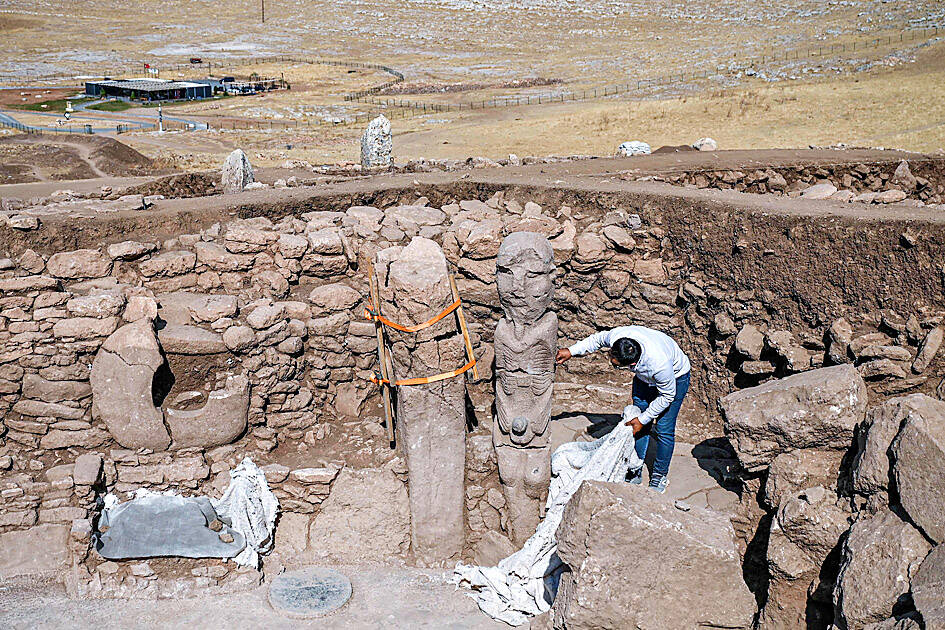The dry expanses of southeastern Turkey, home to some of humanity’s most ancient sites, have yielded fresh discoveries in the form of a stone phallus and a colored boar.
For researchers, the carved statue of a man holding his phallus with two hands while seated atop a bench adorned with a leopard, is a new clue in the puzzle of our very beginnings.
The 2.3m statue was discovered at the end of September at Karahantepe, in the heart of a complex of about 20 sites that were home to thousands of people during the Stone Age.

Photo: AFP
Karahantepe is part of the network around UNESCO-listed Gobekli Tepe, a place where our prehistoric ancestors gathered to worship more than 7,000 years before Stonehenge or the earliest Egyptian pyramids.
Necmi Karul, who heads Istanbul University’s Department of Prehistoric Archeology, found the toppled statue that was broken into three sections.
“We found several statues of this kind ... but for the first time here we found the phallus,” said the archeologist, who coordinates the work of a project focused on the area’s settlements.

Photo: AFP
The man lay in one of the first rectangular buildings, probably as a pillar supporting the wooden roof — clues to how people used the site.
Karul said that these settlements bear witness to “a new social order born after the Ice Age.”
“The main reason to start a new kind of architecture is to build a new type of society,” he said.
Gobekli Tepe — which some experts believe was never actually inhabited — might be part of a vast sacred landscape that encompasses other nearby hilltop sites that archeologists believe could be even older.
However, the first modest photographs of the statue released by the Turkish Ministry of Culture and Tourism led the local press to suspect censorship in the nation that has turned conservative under Turkish President Recep Tayyip Erdogan.
“We are archeologists, censorship doesn’t exist. We had not yet found a phallus,” Karul said, laughing.
Yet there is meaning hidden in the discovery.
“Before leaving a site they [residents] used to crash the pillars and the statues — but before, they broke the nose and the phallus,” he said.
Then the site was filled in, buried under tonnes of sand and earth. Its function remains unknown as do the reasons for the sudden abandonment and destruction of place after apparently hundreds of years of use.
The largest room at the site, surrounded by smaller rooms, seems to have been a kind of gathering place accessed via a narrow passageway, supported by a forest of phallus-shaped pillars topped by a man’s head carved out of the rock.
“Those who entered here knew the symbols ... they knew the meaning. It told them a story, but we don’t know it,” Karul said, adding that no female figures have been found.
Perhaps they were made of wood, he said, hazarding a guess.
No sooner had Karul unearthed the Karahantepe man, when he made another discovery the same week at Gobekli Tepe.
Archeologists found a 1.2m long by 70cm high depiction of a boar, with red eyes and teeth, as well as a black and white body.
The 11,000-year-old wild pig is the first colored sculpture from this period discovered to date, Karul said.
The site was occupied for about 1,500 years before being abandoned. Of the 20 area sites in the Tas Tepe (Stone Hills) project that is coordinated by Karul — which stretches over 120km not far from the border with Syria — only nine are being excavated.
“Work for the next 150 years,” said Karul, adding that the man and the boar would remain where they emerged from the earth, but with the necessary measures to safeguard them.

POLITICAL PRISONERS VS DEPORTEES: Venezuela’s prosecutor’s office slammed the call by El Salvador’s leader, accusing him of crimes against humanity Salvadoran President Nayib Bukele on Sunday proposed carrying out a prisoner swap with Venezuela, suggesting he would exchange Venezuelan deportees from the US his government has kept imprisoned for what he called “political prisoners” in Venezuela. In a post on X, directed at Venezuelan President Nicolas Maduro, Bukele listed off a number of family members of high-level opposition figures in Venezuela, journalists and activists detained during the South American government’s electoral crackdown last year. “The only reason they are imprisoned is for having opposed you and your electoral fraud,” he wrote to Maduro. “However, I want to propose a humanitarian agreement that

ECONOMIC WORRIES: The ruling PAP faces voters amid concerns that the city-state faces the possibility of a recession and job losses amid Washington’s tariffs Singapore yesterday finalized contestants for its general election on Saturday next week, with the ruling People’s Action Party (PAP) fielding 32 new candidates in the biggest refresh of the party that has ruled the city-state since independence in 1965. The move follows a pledge by Singaporean Prime Minister Lawrence Wong (黃循財), who took office last year and assumed the PAP leadership, to “bring in new blood, new ideas and new energy” to steer the country of 6 million people. His latest shake-up beats that of predecessors Lee Hsien Loong (李顯龍) and Goh Chok Tong (吳作棟), who replaced 24 and 11 politicians respectively

Young women standing idly around a park in Tokyo’s west suggest that a giant statue of Godzilla is not the only attraction for a record number of foreign tourists. Their faces lit by the cold glow of their phones, the women lining Okubo Park are evidence that sex tourism has developed as a dark flipside to the bustling Kabukicho nightlife district. Increasing numbers of foreign men are flocking to the area after seeing videos on social media. One of the women said that the area near Kabukicho, where Godzilla rumbles and belches smoke atop a cinema, has become a “real

‘WATER WARFARE’: A Pakistani official called India’s suspension of a 65-year-old treaty on the sharing of waters from the Indus River ‘a cowardly, illegal move’ Pakistan yesterday canceled visas for Indian nationals, closed its airspace for all Indian-owned or operated airlines, and suspended all trade with India, including to and from any third country. The retaliatory measures follow India’s decision to suspend visas for Pakistani nationals in the aftermath of a deadly attack by shooters in Kashmir that killed 26 people, mostly tourists. The rare attack on civilians shocked and outraged India and prompted calls for action against their country’s archenemy, Pakistan. New Delhi did not publicly produce evidence connecting the attack to its neighbor, but said it had “cross-border” links to Pakistan. Pakistan denied any connection to